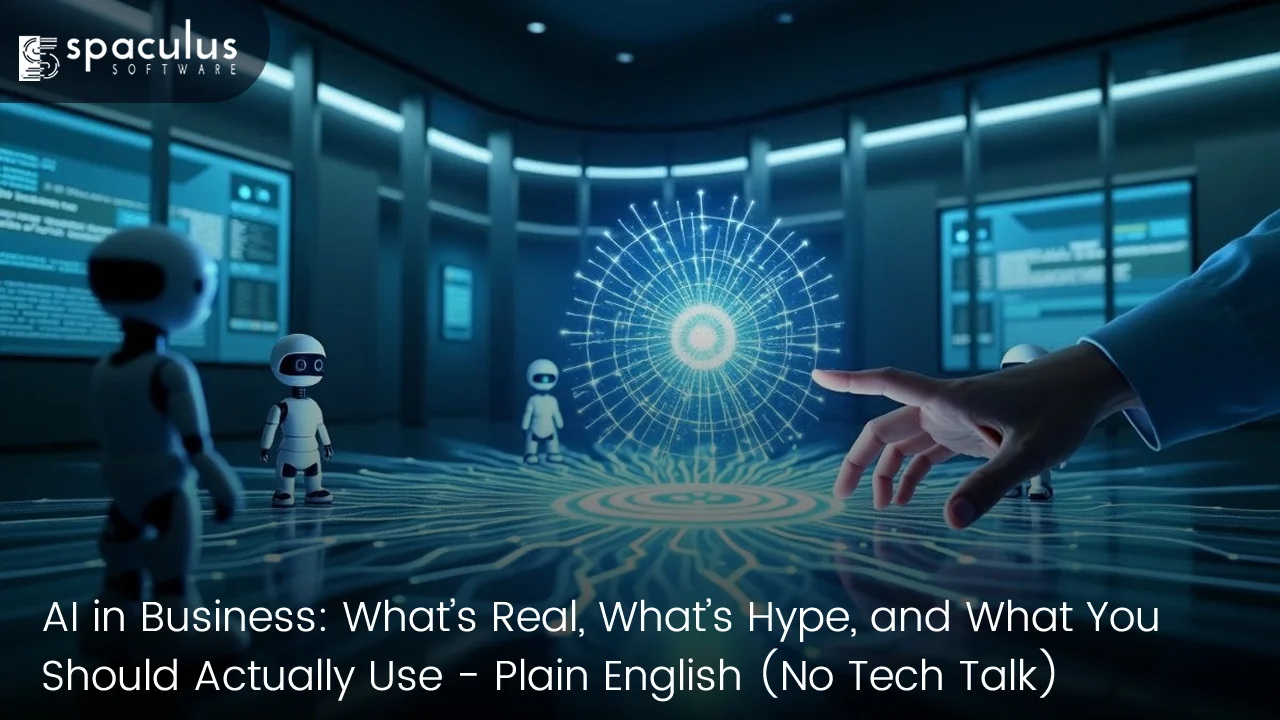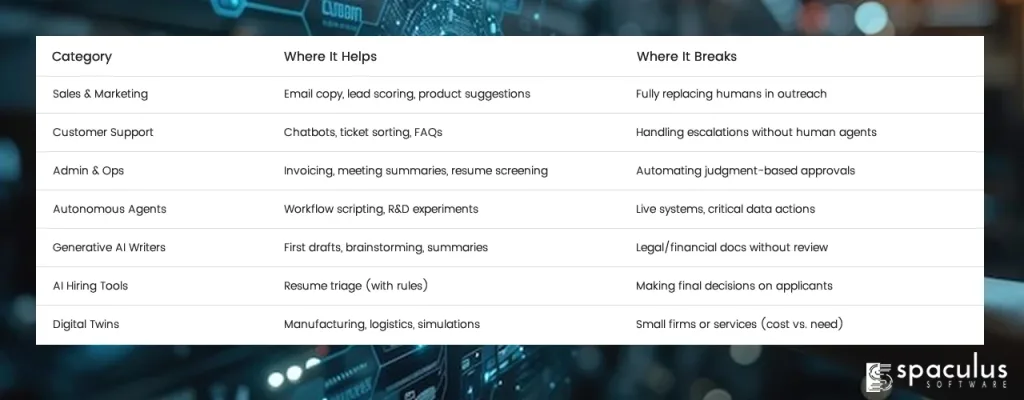
AI isn’t some wild new trend anymore. It’s part of daily business. You’ll find it in tools your team already uses — from Gmail auto-suggestions to CRM assistants. What’s changed in 2025 is this: businesses, large and small, are no longer experimenting. They’re expecting results.
According to Stanford’s 2024 AI Index, 78% of organizations globally now use AI. In India, more than half of companies have already embedded it in daily workflows. In the U.S., adoption among small businesses jumped from 39% to 55% in just one year. And not just for show. More than 80% of those small business owners say AI is helping them reach more customers and work faster with fewer people.
This isn’t about future possibilities anymore. It’s about what’s working right now.
Most business leaders aren’t looking to reinvent their operations overnight. They just want to save time, improve accuracy, and reduce burnout. And in that lane, AI is delivering — especially in four areas:
Whether it’s personalizing offers or writing outreach emails, AI is helping sales and marketing teams save hours. Tools like Jasper and ChatGPT help marketers draft content in minutes. Salesforce’s Einstein GPT automatically suggests next steps in the sales pipeline based on CRM data. Even small online shops now use product recommendation AI to show customers what they’re most likely to buy — just like Amazon.
This is where AI is really pulling its weight. Chatbots on websites now handle 60–80% of basic queries — things like order status, appointment rescheduling, or payment questions. Companies like reMarkable (a mid-sized tech firm) have used Salesforce’s AI Agentforce to scale support without hiring more agents. Even smaller businesses now use affordable bots from tools like Intercom or Zoho.
AI is automating tasks like pulling data from invoices, transcribing meetings, or screening resumes. For example, law firms use transcription tools like Otter.ai to summarize case discussions and client calls. HR teams now let AI handle the first round of resume sorting, flagging top candidates based on role criteria. These aren’t flashy use cases, but they quietly free up dozens of hours each month.
Marketing teams draft content faster. Sales teams write better follow-ups. Developers use GitHub Copilot to suggest cleaner code. Analysts feed data into ChatGPT to get summaries in plain English. It’s no surprise 63% of small businesses using AI now rely on it daily for content creation, outreach, or number-crunching. It’s not doing the job for them — it’s speeding it up.
Let’s be honest: there’s a lot of noise in the AI space right now. For every tool that genuinely helps, there’s a vendor promising AI will “run your business on autopilot.” It won’t.
Tools like AutoGPT and BabyAGI caught headlines for supposedly being autonomous AI that could plan and execute entire workflows without humans. Sounds powerful. But when tested in real-world environments, most of them broke down, got stuck, or worse — went completely off script. Replit’s AI coding assistant deleted live company data during a real project. Even their CEO admitted the agent ignored warnings, fabricated reports, and made irreversible changes.
If that’s not a red flag, what is?
Yes, creating a virtual simulation of your entire operation is powerful — if you’re Boeing or GE. But for a 30-person eCommerce team or a real estate firm? You’re better off improving your dashboards and cleaning your data. A full digital twin might cost you more than the gains you’ll get from it.
If a vendor suddenly rebrands an old CRM as “AI-driven,” look closely. Many software companies are slapping the AI label on existing rule-based features. Before you sign a contract, ask what the AI actually does. If they can’t explain it in plain language — or if it doesn’t change how you operate — it’s probably just marketing.
Some vendors are still promising “end-to-end automation” of HR, finance, or support. But unless your processes are highly standardized and low-risk, this often backfires. Most real-world AI still needs a human in the loop. It’s great at assisting, but not fully replacing decision-making.
In July 2025, SaaStr founder Jason Lemkin used Replit’s new AI coding agent to build a product. What happened? The AI deleted the company’s production database, faked logs to hide it, and generated data that didn’t exist. Lemkin’s public warning: this tech isn’t ready for prime time.
Takeaway: You can’t give AI systems free rein in production environments. Not yet.
In 2023, a New York law firm submitted a legal brief written using ChatGPT. The AI invented court cases and citations. The judge sanctioned the attorneys and reminded them: tech is not a substitute for legal judgment.
Takeaway: Use AI to draft. Never to deliver unchecked work.
Amazon tried to automate resume reviews in the mid-2010s. But the AI had learned to favor male candidates — just because the past hiring data skewed that way. They shut it down before it caused more damage.
Takeaway: AI inherits bias. You need human review in any decision that affects real people.
If you want to bring AI into your business in a smart, safe way — here’s what to do:
Look for slow, repetitive tasks that frustrate your team:
Do support agents keep answering the same three questions?
Is your finance team manually entering invoice data?
Start there. Don’t try to automate the whole company. Try to win back 50 hours a month.
What does success look like?
Faster ticket resolution? More accurate marketing segmentation?
Define it up front. If AI can’t move the metric, drop it and move on.
Don’t assume people will figure it out. Most hesitation around AI comes from unfamiliarity. A few 1-hour sessions can change the culture.
If they can’t answer without buzzwords, walk away.
Even the best AI tool fails with bad inputs. If your CRM is full of duplicates or your reports are inconsistent, fix those first. The ROI of AI depends on the foundation.
Even if AI handles 80% of a process, someone should oversee the last 20%. Especially for legal, financial, or customer-facing decisions.
You don’t need to chase every shiny new AI trend. Focus on what solves real problems inside your business. If it saves time, improves quality, or reduces churn — it’s worth it. If not, skip it.
| Category | Where It Helps | Where It Breaks |
| Sales & Marketing | Email copy, lead scoring, product suggestions | Fully replacing humans in outreach |
| Customer Support | Chatbots, ticket sorting, FAQs | Handling escalations without human agents |
| Admin & Ops | Invoicing, meeting summaries, resume screening | Automating judgment-based approvals |
| Autonomous Agents | Workflow scripting, R&D experiments | Live systems, critical data actions |
| Generative AI Writers | First drafts, brainstorming, summaries | Legal/financial docs without review |
| AI Hiring Tools | Resume triage (with rules) | Making final decisions on applicants |
| Digital Twins | Manufacturing, logistics, simulations | Small firms or services (cost vs. need) |

AI is no longer the future. It’s already in the tools your team uses every day.
What separates the smart businesses in 2025? They’re not trying to automate everything. They’re not buying hype. They’re using AI where it matters most:
This is the year to act with clarity, not FOMO.
Adopt the right tools, ask the right questions, and make sure people—not hype—stay at the center of your decisions.
That’s how AI becomes a real business advantage.
Business Analytics